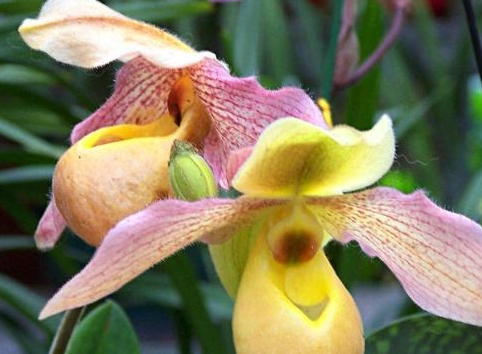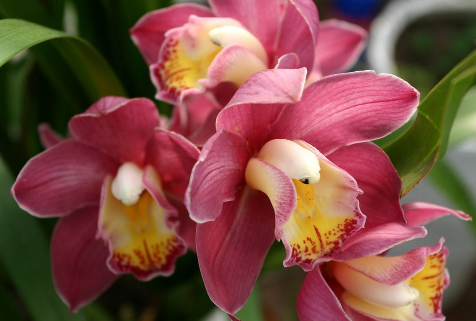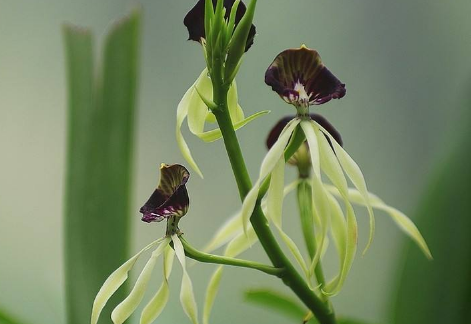Propagation methods of Paphiopedilum
Ramet propagation
Ramet propagation is the main propagation method of Paphiopedilum. Potted Paphiopedilum can be divided once every two or three years. Generally, there will be a short dormant period after flowering, and it can be divided at this time.
First of all, take the plant out of the pot and clean up the soil from the roots so as not to hurt the buds. Separate the plant, each with two or three buds, the thicker buds can be divided into a separate plant, plant the plant in a flowerpot, put it in a cool place, and soon the root of the plant will recover.

Sowing and reproduction
The seeds of Paphiopedilum are very small and it is difficult to sow them. First of all, the embryo of Paphiopedilum seed should be cultured in aseptic test tube. After the seeds germinate in the test tube, they have to go through two or three times of seedling separation and transplantation, and the test tube can be removed when the seedlings of Paphiopedilum grow to about 3 cm. Generally speaking, it takes 4-5 years for Paphiopedilum to blossom.
The breeding and breeding methods of Paphiopedilum are introduced so much with Bigfoot. Paphiopedilum is an excellent potted orchid, and we must not miss it.
The culture method of Paphiopedilum 1. Soil
Potted plants of Paphiopedilum can be configured with rotten leaf soil, peat and so on. When you put on the basin, you can pad a layer of broken brick particles in the basin to maintain good air permeability and be conducive to the growth of plant roots.
two。 Temperature
Paphiopedilum likes warm environment, and the suitable temperature of different varieties is also different. the suitable temperature of green leaf variety is 12-18 ℃, the suitable temperature of variegated leaf is 15-25 ℃, the suitable temperature in winter is 10-15 ℃, and the summer temperature should not be higher than 30 ℃. Get indoors in time when the winter temperature is below 10 ℃.
3. Light
Magnolia shade, the growth process needs the right amount of light, the spring had better be in the semi-overcast environment; hot summer, need a lot of shade, can see light in the morning and evening; be sure to bask in the sun in winter.
4. Moisture content
Paphiopedilum likes the humid environment and is not resistant to dryness. it is necessary to keep the basin soil moist, which can be watered a little dry, and sprinkle water around the plant in summer to increase air humidity. Attention should be paid to ventilation and proper water control during the rainy season.
Culture methods of Paphiopedilum
Aristolochia is an evergreen perennial herb. Native to tropical Asia to Solomon Islands. About 10 species are produced in China, mainly distributed in Yunnan, Guangxi, Guizhou and other regions, and about 50 species in nature.
There was no false stem in morphology, and the aboveground stem was extracted from the rhizome. Leaves banded, leathery, surface furrowed, dark green or patchy. Flowers terminal, often a single flower, a few species have several. Lateral sepals connate, often hidden behind labellum, middle sepals large and erect above; lateral petals often narrow and long, or twisted, labellum large and cucullate, core column thick and short, with 2 lateral stamens and a large staminodes.
The original species of Paphiopedilum are also beautiful and easy to cultivate, and most of them are native species at present. The main famous native species are introduced below:
Magnolia: native to India, there are potted plants all over China, and it is also an excellent cultivated species of cut flowers.
Philippine Paphiopedilum: native to the Philippines. There are several flowers per inflorescence, like high temperature, can often be cultivated into clusters, with more than 10 flowers.
Dai Ye Julan: produced in Guangxi, Yunnan and Guizhou, China, and also distributed in India. Terrestrial or lithophytic, leaves up to 40 cm long. Flowers solitary.
Sumatra Guran: for ^ 5. A variation of cm 1667 ^ ^ > ^ 711 ^. Its biggest advantage is that a branch has many flowers and blossoms every year, and a big clump can blossom every year. The flowers are pure green and the lips are nearly white.
Apricot Magnolia: a newly discovered new species, native to Bijiang, Yunnan. Attached to the rock wall in the place of origin, the back of the leaf has bony protuberances and purple dense spots, and the flowers are apricot yellow.
Hong Kong Paphiopedilum: originally from South China. The florescence is from June to September. It is suitable for cultivation in medium temperature greenhouse.
White Aristolochia: the flower is white, the florescence is from April to August. It is suitable for cultivation in high temperature greenhouse.
In the ecological habits of Paphiopedilum, most of the original species are born in humus-rich soil under temperate climatic forests, or under shrubs or in moss on rocks. Like the overcast and moist environment, avoid stagnant water. No dormancy.
The propagation method of Paphiopedilum is commonly used in the propagation of Paphiopedilum. It is generally advisable to wait until the mother plant is long enough to make a ramet, and those who are thriving should do it once every two or three years. The new strain should be born at the time of division.
It is suitable to have 3 seedlings. It is often combined with changing pots when new seedlings are first seen in spring.
The root system of cultivation and maintenance of Paphiopedilum is underdeveloped, and it does not have aerial root and pseudo-bulb, so its cultivation substrate needs good water retention. Generally, 50% peat soil is added to the bark matrix. Paphiopedilum has no dormant period, so it needs to be watered constantly all the year round to keep the substrate moist enough, too much water or stored on leaves and buds for a long time, easy to bow | decay. Summer must be shaded by the sun and avoid bright light. Different species need different temperatures when they are cultivated. Some species originating in India and China can survive at the lowest temperature of about 101; for species originating in the Philippines and other places, the lowest temperature is 140181; modern hybrid species require a higher temperature. The mature diluted cake fertilizer and water should be applied once a month during the growing period. after fertilization, the leaves are bright green and bright, and fertilization can be continued. If the leaves turn yellow, indicating poor root growth, fertilization should be stopped, otherwise the rotten roots will die.
When horticultural use is used for indoor furnishings in winter, it should be placed in a ventilated place with sufficient light.
The flower shape of Paphiopedilum is strange, beautiful, colorful and colorful. It is one of the most famous flowers in the world, and it is one of the earliest and most popular "foreign orchids" in the world. Its florescence can be as long as 4 months, and it is an ideal high-grade potted flower for indoor study, living room and bedroom. In recent years, it is often matched with asparagus, asparagus, ferns and other cut leaves as an elegant vase flower art to decorate the room.
- Prev

Matters needing attention in the Culture of Cymbidium
1. Cymbidium is originally a plant growing in mountainous areas at high altitude. it requires high ventilation conditions and should be protected in a cool place. two。 Cymbidium can not be watered too often, the soil can be properly dry, watering flowers and leaves must be a small amount, or let the water be dried quickly, too much water flowing into the center of the leaves will affect plant growth.
- Next

Propagation method of octopus orchid
The ramet time of octopus orchid is generally selected in summer, and spring is the peak period of plant growth, and the ramet is easier to survive. The ramet method takes the exuberant plants out of the pot and pays attention to protecting the roots. It can shake off part of the soil, cut off the aged or dead roots, and trim the leaves. Divide the plants into clusters
Related
- Fuxing push coffee new agricultural production and marketing class: lack of small-scale processing plants
- Jujube rice field leisure farm deep ploughing Yilan for five years to create a space for organic food and play
- Nongyu Farm-A trial of organic papaya for brave women with advanced technology
- Four points for attention in the prevention and control of diseases and insect pests of edible fungi
- How to add nutrient solution to Edible Fungi
- Is there any good way to control edible fungus mites?
- Open Inoculation Technology of Edible Fungi
- Is there any clever way to use fertilizer for edible fungus in winter?
- What agents are used to kill the pathogens of edible fungi in the mushroom shed?
- Rapid drying of Edible Fungi

